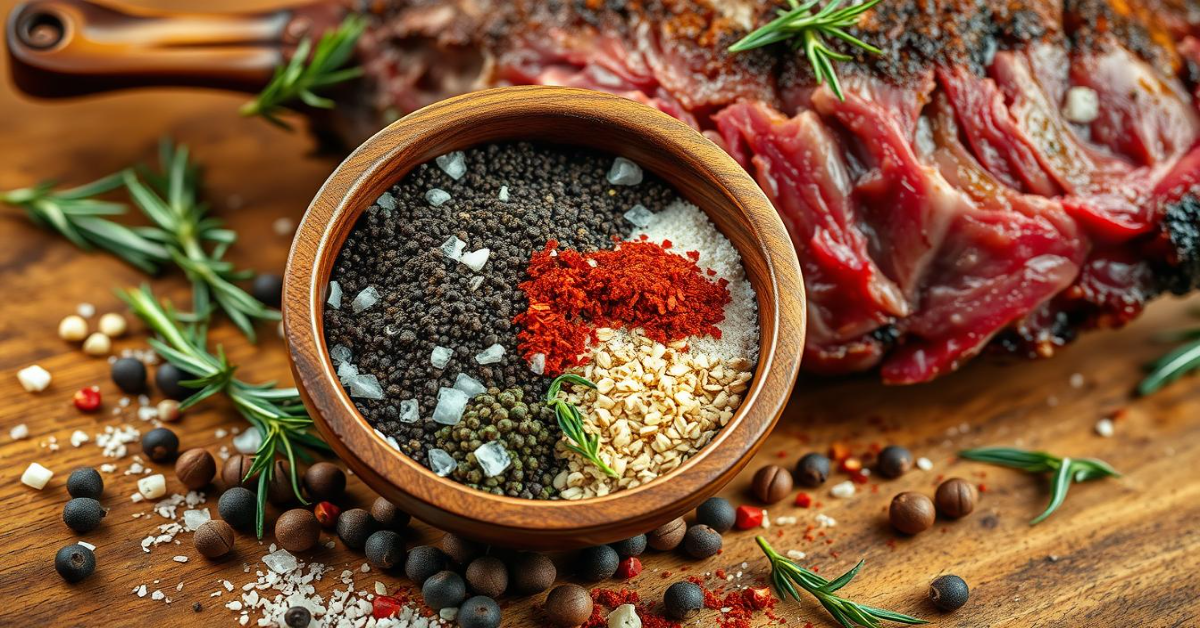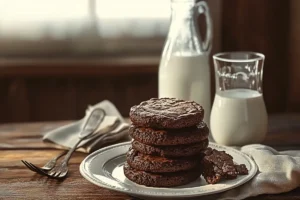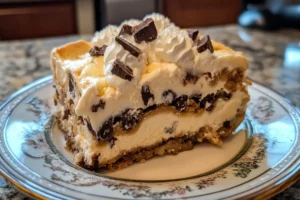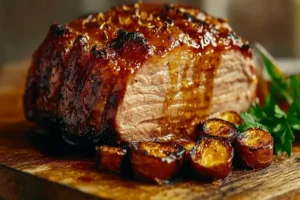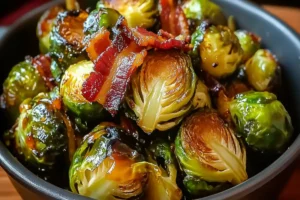The smell of a perfectly seasoned prime rib seasoning roast is irresistible. It brings families and friends together, creating memories. But getting that restaurant-quality flavor at home seems hard. Don't worry, with the right seasoning, you can impress your guests.
In this guide, I'll show you seven key steps for perfect prime rib seasoning. You'll learn how to pick the best spice blend and when to apply it. Follow these tips to make a prime rib that rivals the best steakhouses. Get ready to make a roast that everyone will love.
Table of contents
Understanding Prime Rib and Its Importance
Prime rib is called the “king of roasts” for its rich flavor and tender texture. It’s a top choice for steak lovers and fancy restaurants. The right seasoning is key to bringing out its natural taste, creating a tasty crust, and cooking it evenly.
What Makes Prime Rib Special
Prime rib is a big cut with three or more ribs, roasted whole or as a standing rib roast. It has more fat and marbling, making it rich and tender. Compared to ribeye steak, prime rib is more indulgent, with deeper flavors and a softer texture.
The Role of Proper Seasoning
Seasoning is crucial for prime rib, as it boosts its natural flavors and forms a tasty crust. A dry brine or spice mixture is better than marinades. It creates a flavorful crust that keeps the juices in and enhances the taste.
Choosing the right seasoning blend, like salt, pepper, garlic, and herbs, can elevate a prime rib. Understanding seasoning’s role lets you bring out the best in this amazing beef. You’ll impress your guests with a prime rib roast that rivals restaurant quality.
Essential Ingredients for Prime Rib Seasoning
Making the perfect prime rib begins with a tasty seasoning mix. The main ingredients are salt, black pepper, garlic powder, onion powder, and dried herbs like rosemary and thyme. Paprika and mustard powder are also key, as they add depth to the beef’s flavor and create a tasty crust.
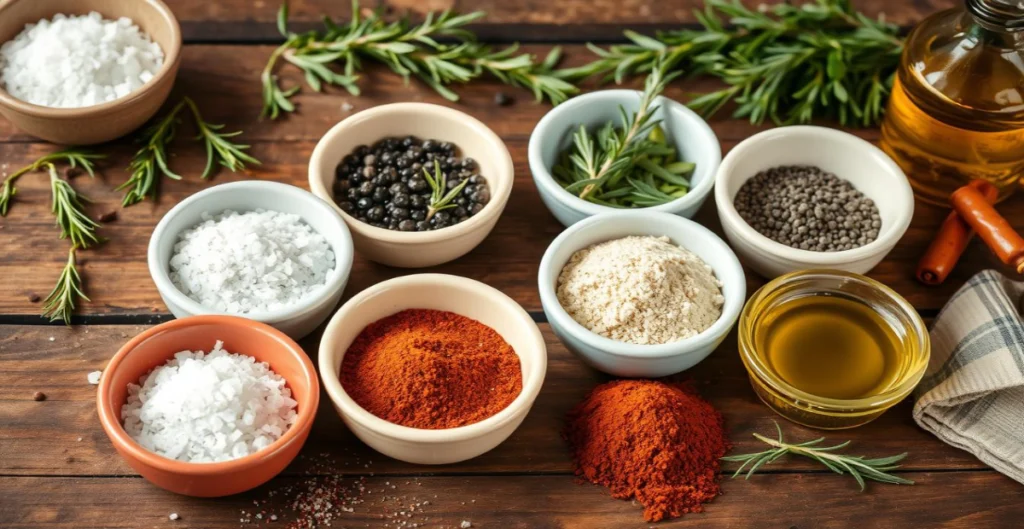
For a bit of spice, add some cayenne pepper. Smoked paprika brings a smoky flavor, reminiscent of barbecue. A pinch of brown sugar can also add a sweet touch to the seasoning or marinade.
- Kosher salt
- Black pepper
- Garlic powder
- Onion powder
- Dried rosemary
- Dried thyme
- Paprika
- Mustard powder
- Cayenne pepper (optional)
- Smoked paprika (optional)
- Brown sugar (optional)
Combining these ingredients creates a seasoning that brings out the best in the beef. It makes the prime rib tender and full of flavor. Feel free to adjust the amounts to suit your taste preferences and enjoy your delicious roast.
"The secret to a truly exceptional prime rib lies in the seasoning. With the right blend of spices and herbs, you can transform a good roast into a culinary masterpiece."
The Science Behind Perfect Prime Rib Seasoning
Getting the perfect flavor and texture in your prime rib is all about seasoning science. Salt tenderizes the meat, while herbs and spices add flavor. Each step is important for the final taste.
Salt and Its Tenderizing Effects
Salt is key for prime rib seasoning. It pulls moisture from the meat and then absorbs it back, along with salt. This makes the meat more flavorful and tender.
Flavor Development and Penetration
Herbs and spices in your prime rib dry rub or prime rib spice blend create deep flavors. These flavors mix well with the beef’s taste. They penetrate deep into the meat, making every bite rich and complex.
Creating the Perfect Crust
The dry rub also helps create a tasty crust. When the roast browns, the rub’s ingredients caramelize. This adds texture and beauty to the dish.
Knowing the science of seasoning is crucial for perfect prime rib. By balancing salt, herbs, and spices, you can make your prime rib incredibly flavorful and tender.
Basic Prime Rib Dry Rub Recipe
Getting the perfect prime rib roast starts with a great seasoning blend. This prime rib roast seasoning recipe adds bold, savory flavors to your beef. It creates a delicious crust. Whether you’re experienced or just starting, this dry rub will make your beef seasoning blend taste like it came from a restaurant.

The recipe mixes a few key ingredients: 2 tablespoons of sea salt, 2 teaspoons of black pepper, and 2 tablespoons of minced fresh rosemary. It also includes 1 tablespoon of minced fresh thyme, 1 tablespoon of garlic powder, 1 teaspoon of onion powder, 1/2 tablespoon of smoked paprika, and 3 tablespoons of dark brown sugar.
This blend is not only tasty but also helps form a beautiful crust on the prime rib roast. The sea salt tenderizes the meat. The fresh herbs and spices add depth and complexity. The brown sugar adds a sweet touch that balances the savory flavors.
To use this rub, just spread it evenly over the prime rib roast. Make sure to cover the fat cap too. For the best results, let the rub sit on the meat for at least 1 hour before cooking. This allows the flavors to fully penetrate the beef. The rub stays good for about 3-4 days, so you can make it ahead of time.
This rub recipe is for a 5-7 pound prime rib roast. If your meat is bigger, just double the ingredients. With this classic prime rib roast seasoning blend, you’re on your way to a mouthwatering, perfectly seasoned prime rib. It’s sure to impress your guests and leave them wanting more.
Advanced Seasoning Techniques and Variations
Prime rib is more than just salt and pepper. It’s a canvas for flavors. Try these advanced seasoning techniques and unique variations to elevate your garlic herb prime rib seasoning.
Herb-Forward Blends
Make a seasoning blend with fresh rosemary, thyme, and garlic. These herbs will fill your prime rib spice mixture with aroma. Your roast will have a mouthwatering crust and rich flavor.
Spicy Alternatives
For a spicy twist, add cayenne pepper or chili powder. This will add a subtle kick to the prime rib. It’s a surprising twist to your dish.
Butter-Based Applications
Enhance your prime rib with a butter-based seasoning. Mix the dry rub with unsalted butter. Coat the roast and let the melted butter baste it. This makes the meat incredibly tender and flavorful.
Success with these techniques comes from finding the right balance. Experiment and adjust to get your ideal garlic herb prime rib seasoning and prime rib spice mixture.
Proper Timing and Temperature Guidelines
To get the perfect prime rib roast, timing and temperature are key. First, let the prime rib dry brine or rib roast rub-coated cut come to room temperature. After seasoning, chill the roast in the fridge for 2-4 hours or overnight. This step lets the flavors mix and the seasoning soak into the meat.
When it’s time to cook, start with a high heat of 450°F (232°C) for 20 minutes. This step creates a tasty crust. Then, lower the oven to 325°F (163°C) and cook until it’s just right. Use a meat thermometer to check the internal temperature. Aim for 120°F (49°C) for rare, 130°F (54°C) for medium-rare, or 140°F (60°C) for medium.
After the prime rib reaches the right temperature, let it rest for 15-20 minutes before slicing. This resting time helps the juices spread, making the meat juicier and more flavorful.
- Bring the prime rib to room temperature before seasoning.
- Apply the prime rib dry brine or rib roast rub and let the seasoned roast rest in the refrigerator for 2-4 hours or overnight.
- Start with a high-heat roast at 450°F (232°C) for 20 minutes, then reduce to 325°F (163°C).
- Use a meat thermometer to achieve the desired doneness: 120°F (49°C) for rare, 130°F (54°C) for medium-rare, or 140°F (60°C) for medium.
- Let the cooked prime rib rest for 15-20 minutes before slicing.
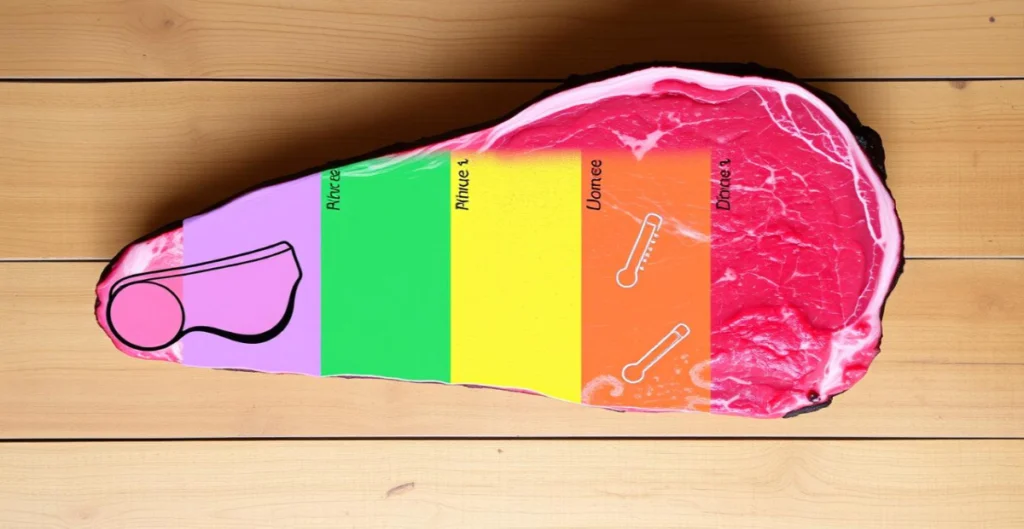
By sticking to these timing and temperature tips, you’ll make a prime rib roast that’s both perfectly cooked and full of flavor.
Application Methods for Prime Rib Seasoning
Seasoning your prime rib can be done in two main ways: dry rub and marinade. Each method has its own benefits, helping you achieve a flavorful and tender roast. Let’s look at how to use these seasoning techniques.
Dry Rub Application
The dry rub is key to your prime rib’s taste. Begin by drying the roast with paper towels. This makes the rub stick better to the meat. Then, cover the whole prime rib with the dry rub, rubbing it in to get the flavors deep into the meat.
Marinade Integration
Adding a marinade to your dry rub can make the flavors even stronger. Mix the dry rub with olive oil or melted butter to make a paste. This paste helps the seasonings get into the meat better. It also helps create a tasty crust when cooking.
Choose the method you like best, but make sure the seasoning covers the whole prime rib. This ensures every bite is full of flavor, making your roast truly special.
Common Seasoning Mistakes to Avoid
Seasoning your prime rib right is key. Avoiding common mistakes can make all the difference. These include under-seasoning and using old spices. These errors can ruin the taste and texture of your roast.
One big mistake is under-seasoning the meat, especially with salt. Salt is vital for flavor and tenderness. Without enough, your prime rib will taste bland.
Another mistake is using low-quality or stale spices and herbs. Fresh, good spices are needed for a rich flavor. Old spices can make your prime rib taste dull.
- Don’t forget to let the seasoning penetrate the meat well. Give your prime rib plenty of time – at least a few hours, or up to 4 days – for the flavors to meld.
- Also, avoid overcooking the roast. A nice crust is good, but overcooking makes the meat dry and tough.
To get your prime rib seasoning right, use fresh, quality ingredients and don’t be shy with the salt. Let the flavors soak in, and watch the cooking closely to avoid overcooking. Follow these tips for a prime rib spice blend that’s perfect.
Storage and Preparation Tips
Preparing the perfect prime rib roast requires careful storage and seasoning. The secret to success lies in planning ahead.
Making Ahead and Storage
The prime rib dry rub can be made up to 6 months in advance. Store it in an airtight container. This lets the flavors blend together before cooking.
Seasoning Duration Guidelines
Season your prime rib 2-4 hours before cooking, or the night before. This time lets the salt tenderize the meat and enhance flavors. Always bring the seasoned roast to room temperature before cooking for even cooking.
"The secret to a mouthwatering prime rib is in the seasoning. Give it time to work its magic and you'll be rewarded with a juicy, flavorful roast."
By planning ahead and following these tips, you’ll make a prime rib that wows everyone. Embrace the art of preparation, and enjoy your delicious results soon.
Expert Tips for Restaurant-Quality Results
To make the perfect prime rib at home, it’s not just about the meat. Seasoning and preparation are key. I’m an expert in the kitchen, ready to share tips for a prime rib that will wow your guests.
Using freshly cracked black pepper and crushed herbs is crucial. It boosts the flavor of your prime rib. Also, a good meat thermometer ensures it’s cooked just right, whether you like it rare, medium-rare, or medium.
Feel free to mix up your spice blend for a unique taste. Add smoked paprika or cumin to your prime rib seasoning for a special touch. You can make your rub or marinade your own way.
- Season the prime rib well with a dry rub or brine it the night before.
- Let the roast warm up to room temperature before cooking for even cooking.
- Use a meat thermometer to check the internal temperature and avoid overcooking.
- Let the roast rest for 20-30 minutes after cooking to let the juices spread out.
By using these expert tips, you’ll make a prime rib as good as a fancy steakhouse. Show off your cooking skills and enjoy the tasty results.
"The secret to a perfect prime rib lies in the seasoning and preparation. With a few simple tricks, you can elevate your home-cooked roast to restaurant quality."
Conclusion
Crafting the perfect prime rib seasoning is essential for creating a memorable roast that will impress everyone at your table. By mastering the art of seasoning, selecting the right ingredients, and ensuring proper timing and temperature, you can elevate your prime rib dry rub to the next level.
Do you like a classic mix of herbs and spices or something bolder? This guide helps you season your prime rib just right. Letting the rub soak into the meat creates a tasty crust. This brings out the meat's natural flavor and tenderness.
With the tips and recipes here, you're ready to make a prime rib roast that wows. Your family and friends will love it. Make your home cooking look like it came from a restaurant by perfecting your prime rib seasoning.
FAQs
1. What is the best way to season a prime rib?
The best way to season a prime rib is to use a flavorful dry rub made of salt, pepper, garlic powder, paprika, and fresh herbs like rosemary and thyme. Apply the rub generously, ensuring it covers the entire surface of the roast. For even better results, let the seasoning sit on the meat for several hours or overnight to allow the flavors to fully penetrate
2. What is prime seasoning?
Prime seasoning refers to a blend of spices and herbs specifically designed to enhance the flavor of prime rib. It typically includes a combination of salt, pepper, garlic, paprika, and herbs like rosemary and thyme, which complement the rich taste of the beef.
3. What is prime rib rub made of?
Prime rib rub is commonly made of coarse salt, freshly cracked black pepper, garlic powder, onion powder, smoked paprika, and dried or fresh herbs like rosemary, thyme, or parsley. Some variations may include cayenne pepper or chili powder for a spicy kick.
4. How to add flavor to prime rib?
To add flavor to prime rib, use a well-balanced seasoning rub or marinade. You can also add flavor by inserting garlic cloves into small slits in the meat, basting with melted butter or beef stock during roasting, and cooking the prime rib with aromatic herbs and vegetables. Letting the meat rest before serving ensures all the flavors are locked in.
5. What makes prime rib special?
Prime rib is loved for its rich, beefy taste and tender feel. It's a favorite for holiday meals and special events.
6. Why is proper seasoning essential for prime rib?
Good seasoning boosts the meat's natural taste. It also helps create a tasty crust and ensures it cooks evenly.
7. What are the key ingredients for a perfect prime rib dry rub?
The main ingredients are salt, black pepper, garlic powder, onion powder, and dried herbs like rosemary and thyme. Paprika and mustard powder are also key.
8. How does salt impact the flavor and texture of prime rib?
Salt tenderizes the meat by pulling out moisture and then soaking it back in. This makes the meat more flavorful.
9. What is a classic prime rib dry rub recipe?
A classic recipe uses 3 tablespoons of salt and 2 tablespoons of black pepper. Add 1 tablespoon each of garlic powder, onion powder, paprika, dried rosemary, and thyme. Finish with 1 teaspoon of mustard powder.
10. What are some advanced seasoning techniques for prime rib?
Advanced methods include using fresh herbs like rosemary and thyme. Additionally, you can experiment with spicy rubs featuring cayenne or chili powder. For an added layer of richness, butter-based applications work exceptionally well.
11. How should I apply the seasoning to the prime rib?
To begin, dry the roast thoroughly with paper towels. Next, coat it evenly with the rub, ensuring you massage it into the meat for maximum flavor. If you prefer a marinade, simply mix the dry rub with olive oil or melted butter before application.
12. What are common mistakes to avoid when seasoning prime rib?
One key mistake is under-seasoning, particularly with salt. Moreover, it’s important to use fresh spices to achieve the best flavor. Allowing the seasoning to soak into the meat is also crucial—don’t skip this step. Lastly, be mindful of not overcooking the roast, as it can compromise both flavor and texture.
13. How far in advance should I season the prime rib?
Ideally, season the prime rib 2-4 hours before cooking. However, for the best results, season it overnight. This extra time allows the salt and flavors to fully penetrate the meat, enhancing its taste and tenderness.
14. What are some expert tips for achieving restaurant-quality prime rib at home?
For the best taste, use freshly cracked pepper and crushed herbs. A good meat thermometer is key for precise cooking. After cooking, let the roast rest for 20-30 minutes.
A Note from the Chef
Let us know if you try it, your feedback fuels our passion!

